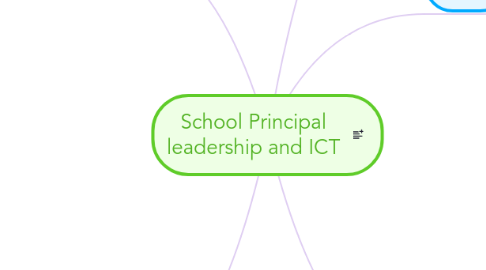
1. Change and sustainability
1.1. Rogers, E.M.(2003). Diffusion of innovations
1.1.1. Leaders' attitude to change(+)
1.1.1.1. Organisational innovativeness
1.1.2. Attributes of innovations: Relative advantage, Compatibility, Complexity, Trialability, Observability
1.1.3. Rate of adoption
1.1.4. Technology Adoption Cycle
1.1.4.1. Innovators
1.1.4.2. Early adopters
1.1.4.3. Early majority
1.1.4.4. Late majority
1.1.4.5. Laggards
1.2. Ecological metaphor (Law, Yuen & Fox, 2011)
1.3. Education epidemic (Hargreaves, 2003)
1.4. The Seven Principles of Sustainable Leadership
1.4.1. Sustainable leadership creates and preserves sustaining learning.
1.4.2. Sustainable leadership secures success over time.
1.4.3. Sustainable leadership sustains the leadership of others.
1.4.4. Sustainable leadership addresses issues of social justice.
1.4.5. Sustainable leadership develops rather than depletes human and material resources.
1.4.6. Sustainable leadership develops environmental diversity and capacity.
1.4.7. Sustainable leadership undertakes activist engagement with the environment.
2. Multilevel ecosystem
2.1. 4 mysteries of successful ICT implementation
2.1.1. Mystery one: What decide what actions people will take during adoption?
2.1.1.1. Acceptance
2.1.2. Mystery two: What decide people's involvement?
2.1.2.1. Accountability
2.1.3. How to equip principals and teachers for the change?
2.1.3.1. Knowledge transfer
2.1.4. What make the change happen in school?
2.1.4.1. The power of people
2.2. Connectors
2.2.1. Principals
2.2.1.1. Organisational routines as change strategy
2.2.2. Teachers
2.2.2.1. Five stages of “instructional evolution” in ACOT
2.2.2.1.1. 1. Entry
2.2.2.1.2. 2. Adoption
2.2.2.1.3. 3. Adaptation
2.2.2.1.4. 4. Appropriation
2.2.2.1.5. 5. Invention
2.3. Parents
3. School culture/organization
3.1. Organizational structure
3.1.1. Centralization
3.1.2. Complexity
3.1.3. Formalization
3.1.4. Interconnectedness
3.1.5. Organizational slack
3.1.6. size
3.1.7. External factors
3.1.7.1. System openness
3.2. e-confient school
3.2.1. 10 key features
3.2.1.1. High levels of staff confidence, competence, leadership
3.2.1.2. Re-engineered teaching, learning and assessment, integrating effective use
3.2.1.3. Leading & managing distributed and concurrent learning
3.2.1.4. Effective application within organisational and management processes
3.2.1.5. Secure, informed professional judgement
3.2.1.6. Coherent personal learning development, support and access – for all leaders, teaching and non-teaching staff
3.2.1.7. Resource allocation to ensure sustainable development
3.2.1.8. Availability, access and technical support
3.2.1.9. Pupils/students with high ICT capability
3.2.1.10. School as the lead community learning/information hub
3.3. Learning Environment
3.3.1. Approach for L&T (knowledge construction curriculum)
3.3.1.1. Realize the New learning environment -more flexible, interactive, and student-centred -call for holistic strategy to respond to changing demands at different levels.
3.3.2. Infrastructure support
3.3.2.1. Control or Ask for Resources to meet all related expenses on upgrading IT hardware and software, higher bandwidth of Internet connection.
3.3.3. ICT resource management
3.3.3.1. Need to strengthen school leadership to cope with two major e-challenges
3.3.3.1.1. effective resources planning to capture the opportunities that evolving technology promises
3.3.3.1.2. change management to embrace a new IT-enabled environment
3.3.4. Student learning with ICT
3.3.4.1. set learning targets for students at different key learning stages to improve their learning abilities with the support of IT
4. Policy
4.1. Understanding, formulating, and evaluating policies
4.1.1. Elements of policy statement
4.1.1.1. Problem definition
4.1.1.1.1. Goals
4.1.1.1.2. Instruments
4.1.2. Policy consistency
4.1.2.1. 3. Defining Inputs
4.1.2.2. 4. Research
4.1.2.3. 5. Developing Options
4.1.2.4. 6. Recommending, Seeking Decisions
4.1.2.5. 7. Communication
4.1.2.6. 8. Assessing Quality
4.1.3. Policy analysis
4.1.3.1. Normative
4.1.3.2. Legal
4.1.3.3. Logical
4.1.3.4. Empiricia
4.2. Enhancing School Leadership for the Knowledge Age
4.2.1. Develop 8 Key Learning Areas (KLA)
4.2.2. Develop 9 Generic Skills (GS)
5. Successful leadership
5.1. Personal characteristics
5.2. Leadership theories
5.2.1. Strategic Leadership of ICT
5.2.2. Instructional leadership (Leithwood)
5.2.3. Distributed leadership (Spillane)
5.2.4. E-leadership
5.3. Leadership practices
5.4. Leader competencies
5.4.1. Knowledge on Educational technology
5.4.2. Knowledge on leading change
5.5. Principals' Continuing Professional Development (CPD)
5.5.1. Six core areas of leadership
